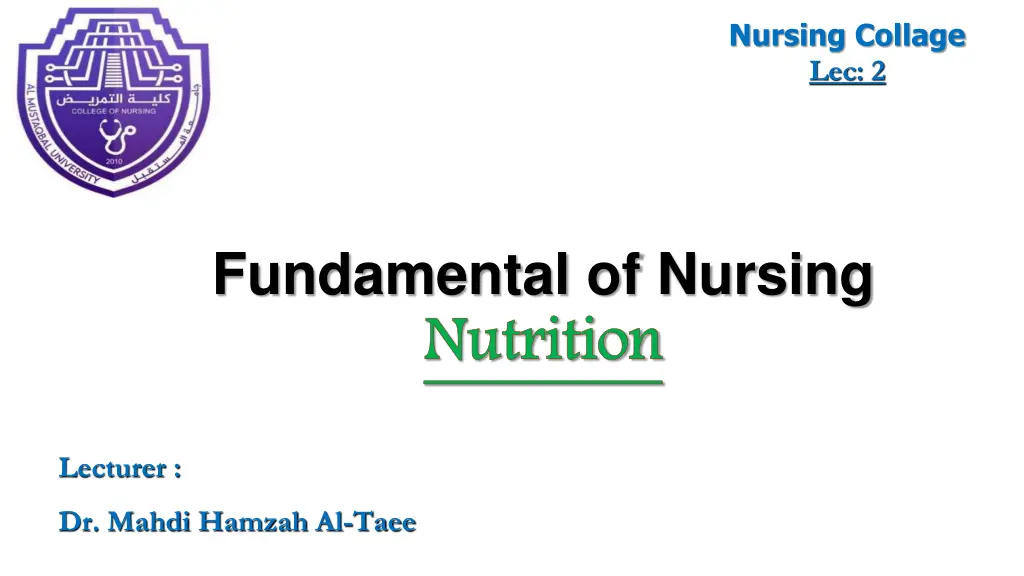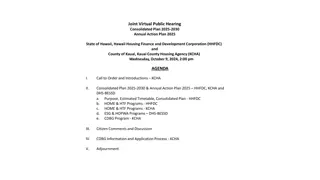
Understanding the Science of Nutrition in Nursing Education
Explore the vital role of nutrition in nursing, covering nutrients, diet, food, and the importance of good nutrition for overall health and well-being. Learn about different classes of nutrients, the processes of eating, digestion, and absorption, and the significance of proper nutrition in various healthcare settings and patient care.
Download Presentation

Please find below an Image/Link to download the presentation.
The content on the website is provided AS IS for your information and personal use only. It may not be sold, licensed, or shared on other websites without obtaining consent from the author. If you encounter any issues during the download, it is possible that the publisher has removed the file from their server.
You are allowed to download the files provided on this website for personal or commercial use, subject to the condition that they are used lawfully. All files are the property of their respective owners.
The content on the website is provided AS IS for your information and personal use only. It may not be sold, licensed, or shared on other websites without obtaining consent from the author.
E N D
Presentation Transcript
Nursing Collage Lec: 2 Fundamental of Nursing Nutrition Nutrition Lecturer : Dr. Mahdi Hamzah Al-Taee
Nutrition The science of nutrition is the study of how food nourishes the body. Nutrients are specific biochemical substances used by the body for growth, development, activity, reproduction, lactation, health maintenance, and recovery from illness or injury. Diet: An element that is used in many tradition treatments of disease or food prescribed a physician. Food: are nourish the body and sometimes to treat particular illnesses for which dietary has an accepted scientific rationale.
Its combination of processes by which the living organism can receives and utilizes the nutrient from food for the maintenance of its functions, growth of tissues, and the production of energy. These combinations are: 1.Eating 2.Digestion. 3.Absorption. 4.Metabolism. 5.Excretion and Egestion.
Classes of Nutrients: 1.Nutrients supply energy: a. Carbohydrate. b. Protein. c. Lipid (fat). 2.Nutrients needed to regulate and control body processes a. Vitamins. b. Minerals. c. Water
Good nutrition is important for: 1.The ability of adults to work well. 2.The bodies resistance to infectious disease. 3.Healthy pregnancy and deliveries. 4.Physical and mental development of children and adolescent. 5.Eradication of malnutrition diseases.
Types of Hospitals Diets Assessment of patient tolerance to the diet: 1. Absence of nausea, vomiting. 2. Absence of diarrhea. 3. Absence of feelings of fullness. 4. Absence of abdominal pain and distention. 5. Feelings of hunger; and the ability to consume at least 50% to 75% of the food on the meal tray.
1.Liquid diets : are used most often as transitional diets when eating resumes after acute illness, surgery or parenteral nutrition. 2.Clear liquid diets contain only foods that are clear liquids at room or body temperature gelatin, fat-free broth, bouillon, ice pops, clear juices, carbonated beverages, regular and decaffeinated coffee, and tea. Because clear liquid diets are inadequate in calories, protein, and most nutrients, progression to more nutritious alternatives is recommended as soon as possible.
3.Full liquid diets contain all the items on a clear liquid diet. Additional items allowed include milk and milk drinks, puddings, custards, plain frozen desserts, pasteurized eggs, cereal gruels, vegetable juices, and milk and egg substitutes in addition to clear liquids. A full liquid diet contains liquids that can be poured at room temperature. High-calorie, high- protein supplements are recommended ifa full liquid diet is used for more than 3 days.
4. Soft Diet: An adequate diet that is moderately low in fiber and lightly seasoned. Often used for patients after surgery or those with mild gastrointestinal distress. May also be used as a transition between liquids and a regular diet. 5. Fat-Restricted Diet: Low-fat diets are intended to lower the patient s total intake of fat. This diet may be used, for example, with patients experiencing chronic cholecystitis (inflammation of the gallbladder) to decrease gallbladder stimulation and as part of dietary interventions for patients with cardiovascular disease, to help prevent atherosclerosis. Total amount of servings would be individually prescribed for each patient.
6. Pureed Diet : Also known as a blenderized liquid diet because the diet is made up of liquids and foods blenderized to liquid form. Used after oral or facial surgery and for patients with chewing and swallowing difficulties. 7. Mechanical Soft Diet: Regular diet with modifications for texture. Used for patients with limited chewing ability or who have had surgery to the head, neck, or mouth.
Nothing By Mouth (NPO) In some cases, such as before surgery to prevent aspiration related to anesthesia and after surgery until bowel sounds return, patients may be ordered nothing by mouth (NPO). NPO may also be necessary for patients undergoing certain medical tests; for patients experiencing severe nausea and vomiting, an inability to chew or swallow, or various acute or chronic GI abnormalities; for those who are comatose; and for women during labor and delivery.
The following measures may provide comfort to patients who are ordered NPO: Encourage or provide good oral hygiene. Provide the patient with ice chips or sips of water as allowed. Urge the patient to avoid watching others eat. Suggest alternate activities at mealtimes.
Factors Affecting Nutrition Physiologic factors 1.Age 2.Gender. 3.State of health. 4.Alcohol abuse. 5.Medication. 6.Mega dose of nutrients supplement.
Physical, Sociocultural, and Psychosocial Factors That Influence Food Choices 1.Socioeconomic status. 2.Religion. 3.Meaning of food. 4.Culture. 5.Additional sociocultural factors include: -Illiteracy. -Language barriers. -Knowledge of nutrition. -Lack of social support. -Social isolation. -Limited ability to purchase of food. -Lack or inadequate cooking and
Thank you 15






















